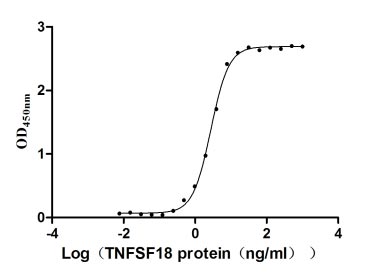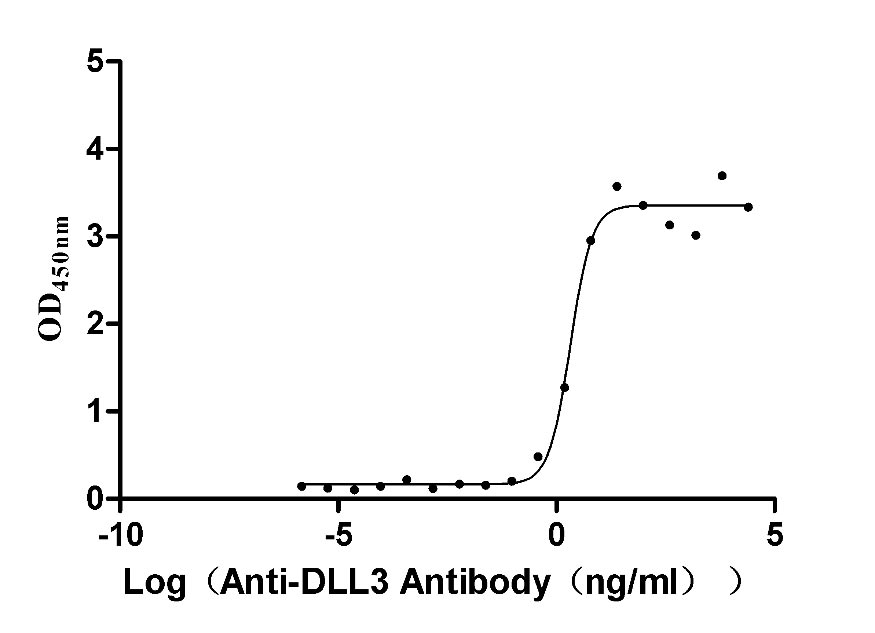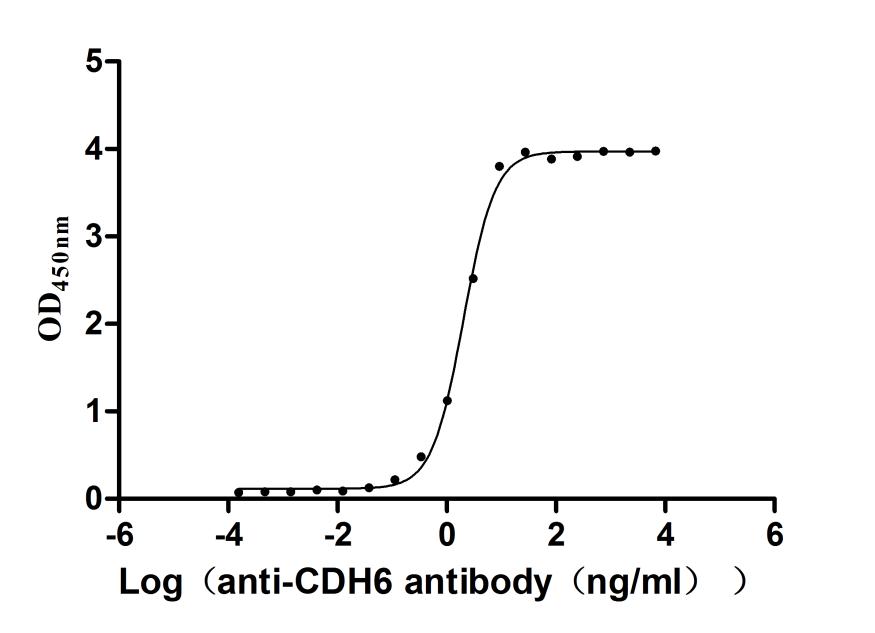Recombinant Human Inhibitor of growth protein 4 (ING4)
-
中文名称:人ING4重组蛋白
-
货号:CSB-YP891792HU
-
规格:
-
来源:Yeast
-
其他:
-
中文名称:人ING4重组蛋白
-
货号:CSB-EP891792HU
-
规格:
-
来源:E.coli
-
其他:
-
中文名称:人ING4重组蛋白
-
货号:CSB-EP891792HU-B
-
规格:
-
来源:E.coli
-
共轭:Avi-tag Biotinylated
E. coli biotin ligase (BirA) is highly specific in covalently attaching biotin to the 15 amino acid AviTag peptide. This recombinant protein was biotinylated in vivo by AviTag-BirA technology, which method is BriA catalyzes amide linkage between the biotin and the specific lysine of the AviTag.
-
其他:
-
中文名称:人ING4重组蛋白
-
货号:CSB-BP891792HU
-
规格:
-
来源:Baculovirus
-
其他:
-
中文名称:人ING4重组蛋白
-
货号:CSB-MP891792HU
-
规格:
-
来源:Mammalian cell
-
其他:
产品详情
-
纯度:>85% (SDS-PAGE)
-
基因名:ING4
-
Uniprot No.:
-
别名:Brain my036 protein; Candidate tumor suppressor p33 ING 1 homolog; Candidate tumor suppressor p33 ING1 homolog; D6Wsu147e; D6Xrf92; ING 1 like protein; ING 4; ING1 like protein; ING4; ING4_HUMAN; Inhibitor of growth family member 4; Inhibitor of growth family member 4 long isoform; Inhibitor of growth protein 4; MGC12557; my036; p29 ING 4; p29 ING4; p29ING4
-
种属:Homo sapiens (Human)
-
蛋白长度:full length protein
-
表达区域:1-249
-
氨基酸序列MAAGMYLEHY LDSIENLPFE LQRNFQLMRD LDQRTEDLKA EIDKLATEYM SSARSLSSEE KLALLKQIQE AYGKCKEFGD DKVQLAMQTY EMVDKHIRRL DTDLARFEAD LKEKQIESSD YDSSSSKGKK KGRTQKEKKA ARARSKGKNS DEEAPKTAQK KLKLVRTSPE YGMPSVTFGS VHPSDVLDMP VDPNEPTYCL CHQVSYGEMI GCDNPDCSIE WFHFACVGLT TKPRGKWFCP RCSQERKKK
-
蛋白标签:Tag type will be determined during the manufacturing process.
The tag type will be determined during production process. If you have specified tag type, please tell us and we will develop the specified tag preferentially. -
产品提供形式:Lyophilized powder
Note: We will preferentially ship the format that we have in stock, however, if you have any special requirement for the format, please remark your requirement when placing the order, we will prepare according to your demand. -
复溶:We recommend that this vial be briefly centrifuged prior to opening to bring the contents to the bottom. Please reconstitute protein in deionized sterile water to a concentration of 0.1-1.0 mg/mL.We recommend to add 5-50% of glycerol (final concentration) and aliquot for long-term storage at -20℃/-80℃. Our default final concentration of glycerol is 50%. Customers could use it as reference.
-
储存条件:Store at -20°C/-80°C upon receipt, aliquoting is necessary for mutiple use. Avoid repeated freeze-thaw cycles.
-
保质期:The shelf life is related to many factors, storage state, buffer ingredients, storage temperature and the stability of the protein itself.
Generally, the shelf life of liquid form is 6 months at -20°C/-80°C. The shelf life of lyophilized form is 12 months at -20°C/-80°C. -
货期:Delivery time may differ from different purchasing way or location, please kindly consult your local distributors for specific delivery time.Note: All of our proteins are default shipped with normal blue ice packs, if you request to ship with dry ice, please communicate with us in advance and extra fees will be charged.
-
注意事项:Repeated freezing and thawing is not recommended. Store working aliquots at 4°C for up to one week.
-
Datasheet :Please contact us to get it.
相关产品
靶点详情
-
功能:Component of HBO1 complexes, which specifically mediate acetylation of histone H3 at 'Lys-14' (H3K14ac), and have reduced activity toward histone H4. Through chromatin acetylation it may function in DNA replication. May inhibit tumor progression by modulating the transcriptional output of signaling pathways which regulate cell proliferation. Can suppress brain tumor angiogenesis through transcriptional repression of RELA/NFKB3 target genes when complexed with RELA. May also specifically suppress loss of contact inhibition elicited by activated oncogenes such as MYC. Represses hypoxia inducible factor's (HIF) activity by interacting with HIF prolyl hydroxylase 2 (EGLN1). Can enhance apoptosis induced by serum starvation in mammary epithelial cell line HC11.
-
基因功能参考文献:
- Splicing type of ING4 affects the translocation of ING4 proteins into the nucleus. PMID: 30403588
- Both CELSR2 and ING4 display increased cytoplasmic staining in breast cancer cells compared to benign epithelium, suggesting a possible role of both genes in the pathogenesis of human mammary neoplasia. PMID: 29489009
- These results demonstrated that overexpression of ING4 can induce the apoptosis of melanoma cells and CD3+ T cells through signaling pathways such as the Fas/FasL pathway, and that ING4 gene therapy for melanoma treatment is a novel approach. PMID: 29207034
- Inhibitor of growth 4 upregulation plus radiotherapy induced synergistic tumor suppression in SPC-A1 xenografts implanted in athymic nude mice. Thus, the restoration of inhibitor of growth 4 function might provide a potential strategy for non-small cell lung cancer radiosensitization. PMID: 27381846
- Results found that ING4 expression was significantly reduced in CRC tissues and associated with increased lymph node metastasis, advanced TNM stage and poor overall survival. Also, ING4 suppressed CRC angiogenesis by inhibition of Sp1 expression and transcriptional activity through destabilization and ubiquitin degradation and down-regulation of Sp1 downstream pro-angiogenic factors MMP-2 and COX-2. PMID: 27806345
- Low ING4 expression is associated with malignant phenotype and temozolomide chemoresistance in glioblastomas. PMID: 27471108
- ING4 directly binds the Miz1 promoter and is required to induce Miz1 mRNA and protein expression during luminal cell differentiation. PMID: 27527891
- The oncogenic role of miR-330 in Hepatocellular Carcinoma Cells is linked to downregulation of ING4. PMID: 28050784
- ING4 binds double-stranded DNA through its central region with micromolar affinity. PMID: 27926782
- results indicate that the combination of ING4 and PTEN may provide an effective therapeutic strategy for HCC PMID: 27421660
- ING4 can facilitate cancer cell sensitivity to chemotherapy and radiotherapy. Although ING4 loss is observed for many types of cancers, increasing evidences show that ING4 can be used for gene therapy. In this review, the recent progress of ING4 regulating tumorigenesis is discussed PMID: 26803518
- ING4 inhibits CRC invasion and metastasis probably via a switch from mesenchymal marker N-cadherin to epithelial marker E-cadherin through downregulation of Snail1 epithelial-mesenchymal transition (EMT)-inducing transcription factor (EMT-TF). PMID: 26936485
- Data show that Ras protein regulates inhibitor of growth protein 4 (ING4)-thymine-DNA glycosylase (TDG)-Fas protein axis to promote apoptosis resistance in pancreatic cancer. PMID: 26544625
- MiR-761 directly targeted ING4 and TIMP2. PMID: 26278569
- Data suggest a close connection between aberrant ING4 expression and the carcinogenesis of human bladder cells. PMID: 25790869
- This review summarizes the recent published literature that investigates the role of ING4 in regulating tumorigenesis and progression, and explores its potential for cancer treatment. [review] PMID: 25968091
- SCF(JFK) as a bona fide E3 ligase for ING4 and unraveled the JFK-ING4-NF-kappaB axis as an important player in the development and progression of breast cancer PMID: 25792601
- work suggests that ING4 can suppress osteosarcoma progression through signaling pathways such as mitochondria pathway and NF-kappaB signaling pathway and ING4 gene therapy is a promising approach to treating osteosarcoma. PMID: 25490312
- The enhanced antitumor activity generated by Ad.RGD-ING4-PTEN was closely associated with activation of the intrinsic and extrinsic apoptotic pathways and additive inhibition of tumor angiogenesis both in vitro and in vivo. PMID: 25571952
- The low expression level of ING4 protein was correlated with high-risk gastrointestinal stromal tumors. PMID: 23504291
- loss of ING4, either directly or indirectly through loss of Pten, promotes Myc-driven prostate oncogenesis. PMID: 24762396
- ING4 level elevation mediated proliferation and invasion inhibition may be tightly associated with the suppression of NF-kappaB signaling pathway. PMID: 24057236
- These findings support a critical role for ING4 expression in normal cells in the non-cell-autonomous regulation of tumor growth. PMID: 23604125
- ING4 acts as an E3 ubiquitin ligase to induce ubiquitination of p65 and degradation, which is critical to terminate NFkappaB activation. PMID: 23624912
- The ING4 Binding with p53 and Induced p53 Acetylation were Attenuated by Human Papillomavirus 16 E6. PMID: 23967213
- these findings suggest that ING4 may be a feasible modulator for the MDR phenotype of gastric carcinoma cells PMID: 23969950
- KAI1 overexpression increases ING4 expression in melanoma. PMID: 24130172
- ING4 may regulate c-MYC translation by its association with AUF1. PMID: 23603392
- Report up-regulation of ING4 expression in sarcoid granulomas. PMID: 23181555
- ING4 negatively regulates NF-kappaB in breast cancer PMID: 23056468
- Data suggested that miR-650 is correlated with the pathogenesis of hepatocellular carcinoma (HCC) and is involved in the HCC tumorigenesis process by inhibiting the expression of ING4. PMID: 22767438
- Loss of ING4 expression is associated with lymphatic metastasis in colon cancer. PMID: 23055189
- Inhibitor of growth 4 may represent an important biomarker for assessing the severity of breast cancer PMID: 22436625
- crystal structure of the ING4 N-terminal domain PMID: 22334692
- Data suggest that ING4 may be a promising target for the treatment for ovarian cancer. PMID: 22228137
- Mechanism of ING4 mediated inhibition of the proliferation and migration of human glioma cell line U251. PMID: 22078444
- In this review, the different properties of ING4 are discussed, and its activities are correlated with different aspects of cell physiology. [Review] PMID: 21971889
- Downregulated expression of inhibitor of growth 4 is associated with colorectal cancers. PMID: 21626442
- These results sustain the view that ING4 is a tumor suppressor in breast cancer and suggest that ING4 deletion may contribute to the pathogenesis of HER2-positive breast cancer. PMID: 21315418
- results suggest that the decreases in nuclear ING4 may play important roles in tumorigenesis, progression and tumor differentiation in head and neck squamous cell carcinoma. PMID: 21310648
- EBNA3C negatively regulate p53-mediated functions by interacting with ING4 and ING5. PMID: 21177815
- Loss of ING4 is associated with breast carcinoma. PMID: 20707719
- Demonstrated decreased ING4 mRNA and expression in 100% (50/50) lung tumour tissues. Furthermore, ING4 expression was lower in grade III than in grades I-II tumours. Reduced ING4 mRNA correlated with lymph node metastasis. PMID: 20716169
- Mutations in ING4 is associated with cancer. PMID: 20705953
- our data suggest an essential role for ING-4 in human astrocytoma development and progression possibly through regulation of the NF-kappaB-dependent expression of genes involved in tumor invasion PMID: 19775294
- A dominant mutant allele of the ING4 tumor suppressor found in human cancer cells exacerbates MYC-initiated mouse mammary tumorigenesis. PMID: 20501848
- over-expression of miR-650 in gastric cancer may promote proliferation and growth of cancer cells, at least partially through directly targeting ING4. PMID: 20381459
- p29ING4 and p28ING5 may be significant modulators of p53 function. PMID: 12750254
- In mice, xenografts of human glioblastoma U87MG, which has decreased expression of ING4, grow significantly faster and have higher vascular volume fractions than control tumours PMID: 15029197
- ING4 induces G2/M cell cycle arrest and enhances the chemosensitivity to DNA-damage agents in HepG2 cells PMID: 15251430
显示更多
收起更多
-
亚细胞定位:Nucleus.
-
蛋白家族:ING family
-
数据库链接:
HGNC: 19423
OMIM: 608524
KEGG: hsa:51147
STRING: 9606.ENSP00000380024
UniGene: Hs.524210
Most popular with customers
-
Recombinant Human Tumor necrosis factor ligand superfamily member 18 (TNFSF18), partial (Active)
Express system: Mammalian cell
Species: Homo sapiens (Human)
-
Recombinant Macaca fascicularis Delta-like protein 3 (DLL3), partial (Active)
Express system: Mammalian cell
Species: Macaca fascicularis (Crab-eating macaque) (Cynomolgus monkey)
-
Recombinant Mouse Cell adhesion molecule 1 (Cadm1), partial (Active)
Express system: Mammalian cell
Species: Mus musculus (Mouse)
-
Recombinant Human Cell adhesion molecule 1 (CADM1), partial (Active)
Express system: Mammalian cell
Species: Homo sapiens (Human)
-
Recombinant Human Cytotoxic and regulatory T-cell molecule (CRTAM), partial (Active)
Express system: Mammalian cell
Species: Homo sapiens (Human)
-
Recombinant Macaca fascicularis Transmembrane 4 L6 family member 1 (TM4SF1)-VLPs (Active)
Express system: Mammalian cell
Species: Macaca fascicularis (Crab-eating macaque) (Cynomolgus monkey)
-
Recombinant Mouse Cadherin-6(Cdh6),partial (Active)
Express system: Mammalian cell
Species: Mus musculus (Mouse)



















